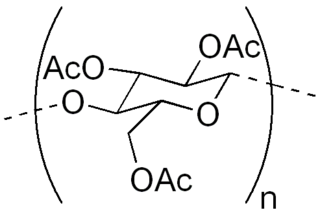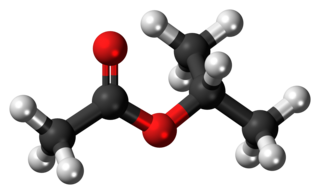
In chemistry, an ester is a chemical compound derived from an acid in which at least one –OH (hydroxyl) group is replaced by an –O–alkyl (alkoxy) group. Usually, esters are derived from a carboxylic acid and an alcohol. Glycerides, which are fatty acid esters of glycerol, are important esters in biology, being one of the main classes of lipids, and making up the bulk of animal fats and vegetable oils. Esters with low molecular weight are commonly used as fragrances and found in essential oils and pheromones. Phosphoesters form the backbone of DNA molecules. Nitrate esters, such as nitroglycerin, are known for their explosive properties, while polyesters are important plastics, with monomers linked by ester moieties. Esters usually have a sweet smell and are considered high-quality solvents for a broad array of plastics, plasticizers, resins, and lacquers. They are also one of the largest classes of synthetic lubricants on the commercial market.

Rayon is a manufactured fiber made from natural sources such as wood and agricultural products that are regenerated as cellulose fiber. The many types and grades of rayon can imitate the feel and texture of natural fibers such as silk, wool, cotton, and linen. The types that resemble silk are often called artificial silk.

Cellulose triacetate, is a chemical compound produced from cellulose and a source of acetate esters, typically acetic anhydride. Triacetate is commonly used for the creation of fibres and film base. It is chemically similar to cellulose acetate. Its distinguishing characteristic is that in triacetate, at least "92 percent of the hydroxyl groups are acetylated." During the manufacture of triacetate, the cellulose is completely acetylated; whereas in normal cellulose acetate or cellulose diacetate, it is only partially acetylated. Triacetate is significantly more heat resistant than cellulose acetate.

Dialysis tubing, also known as Visking tubing, is an artificial semi-permeable membrane tubing used in separation techniques, that facilitates the flow of tiny molecules in solution based on differential diffusion. In the context of life science research, dialysis tubing is typically used in the sample clean-up and processing of proteins and DNA samples or complex biological samples such as blood or serums. Dialysis tubing is also frequently used as a teaching aid to demonstrate the principles of diffusion, osmosis, Brownian motion and the movement of molecules across a restrictive membrane. For the principles and usage of dialysis in a research setting, see Dialysis (biochemistry).

Amyl acetate (pentyl acetate) is an organic compound and an ester with the chemical formula CH3COO[CH2]4CH3 and the molecular weight 130.19 g/mol. It has a scent similar to pears and apples. The compound is the condensation product of acetic acid and 1-pentanol. However, esters formed from other pentanol isomers (amyl alcohols), or mixtures of pentanols, are often referred to as amyl acetate.

Triethyl phosphate is a chemical compound with the formula (C2H5)3PO4 or OP(OEt)3. It is a colorless liquid. It is the triester of ethanol and phosphoric acid and can be called "phosphoric acid, triethyl ester".

Benzyl acetate is an organic ester with the molecular formula C9H10O2. It is formed by the condensation of benzyl alcohol and acetic acid.

Isopropyl acetate is an ester, an organic compound which is the product of esterification of acetic acid and isopropanol. It is a clear, colorless liquid with a characteristic fruity odor.
Dibutyl sebacate (DBS) is an organic chemical, a dibutyl ester of sebacic acid. Its main use is as a plasticizer in production of plastics, namely cellulose acetate butyrate, cellulose acetate propionate, ethyl cellulose, polyvinyl butyral, polyvinyl chloride, polystyrene, and many synthetic rubbers and other plastics. It can be used for plastics in use in the food packaging industry, in plastics used for medical devices, and for pharmaceutical applications, e.g. as a plasticizer for film coating of tablets, beads, and granules. It is also used as a lubricant in shaving lotions, and a flavoring additive in non-alcoholic beverages, ice cream, ices, candy, and baked goods. It provides excellent compatibility with a range of plastic materials, superior properties at low temperatures, and good oil resistivity. Its other names include Morflex, Kodaflex, polycizer, Proviplast 1944 and PX 404. Dibutyl sebacate is also used as a desensitizer in Otto fuel II, a torpedo monopropellant.
Cellulose acetate phthalate (CAP), also known as cellacefate (INN) and cellulosi acetas phthalas, is a commonly used polymer phthalate in the formulation of pharmaceuticals, such as the enteric coating of tablets or capsules and for controlled release formulations. It is a cellulose polymer where about half of the hydroxyls are esterified with acetyls, a quarter are esterified with one or two carboxyls of a phthalic acid, and the remainder are unchanged. It is a hygroscopic white to off-white free-flowing powder, granules, or flakes. It is tasteless and odorless, though may have a weak odor of acetic acid. Its main use in pharmaceutics is with enteric formulations. It can be used together with other coating agents, e.g. ethyl cellulose. Cellulose acetate phthalate is commonly plasticized with diethyl phthalate, a hydrophobic compound, or triethyl citrate, a hydrophilic compound; other compatible plasticizers are various phthalates, triacetin, dibutyl tartrate, glycerol, propylene glycol, tripropionin, triacetin citrate, acetylated monoglycerides, etc.

Cellulose acetate film, or safety film, is used in photography as a base material for photographic emulsions. It was introduced in the early 20th century by film manufacturers and intended as a safe film base replacement for unstable and highly flammable nitrate film.
Tenite is a brand of cellulosic thermoplastic materials produced by the Eastman Chemical Company. Created in 1929, and trademarked in 1932, Tenite has been used in a wide variety of consumer, industrial, architectural and medical applications. Tenite cellulosics are manufactured from renewable raw materials ; they exhibit many of the same tactile and finish properties as wood, yet can easily be molded and extruded. Historically, applications for Tenite have varied from radios and telephones, to toys, toothbrushes and eyeglass frames.
Cellulose fibers are fibers made with ethers or esters of cellulose, which can be obtained from the bark, wood or leaves of plants, or from other plant-based material. In addition to cellulose, the fibers may also contain hemicellulose and lignin, with different percentages of these components altering the mechanical properties of the fibers.
The conservation and restoration of film is the physical care and treatment of film-based materials. These include photographic materials and motion picture.

Methyl ricinoleate is a clear, viscous fluid that is used as a surfactant, cutting fluid additive, lubricant, and plasticizer. It is a plasticizer for cellulosic resins, polyvinyl acetate, and polystyrene. It is a type of fatty acid methyl ester synthesized from castor oil and methyl alcohol.












